Multivariate Analysis of Olfactory Profiles for 140 Perfumes as a Basis to Derive a Sensory Wheel for the Classification of Feminine Fragrances
Abstract
1. Introduction
2. Materials and Methods
2.1. Sample of 140 Feminine Fragrances under Study
2.2. Olfactory Descriptions from Fragrantica’s Website
2.3. Olfactory Descriptions from the H&R Guide
2.4. Olfactory Descriptions from Osmoz
2.5. Additional Variables Computed and Final Matrix of Olfactory Descriptors
- Edchypre was created by coding as one the set of 29 fragrances regarded as “mossy woods” (chypre) by Edwards [12], and zero otherwise.
- Edleather was coded as one for fragrances regarded as “dry woods”, which feature leathery notes [12].
- Edfloral was created by coding as one those perfumes (n = 72) classified as floral, floral–oriental, or soft floral. The purpose was to highlight perfumes with a patent floral character.
- Edoriental takes the value one for the set of 49 perfumes regarded as oriental, soft–oriental, woody–oriental, or floral–oriental.
- Zaldehyde was coded as one for fragrances (n = 42) described as soft floral by Edwards [12] or “aldehydic” in at least one of these directories.
- Zleather and Zfruity were created accordingly.
2.6. Multivariate Statistical Analysis
3. Results
3.1. Olfactory Profiles from Fragrantica and the H&R Guide
3.2. Olfactory Profiles from Osmoz and the H&R Guide
- Oamber (n = 40) was neither significantly correlated with Xbalsamic (p = 0.9) nor Edoriental (p = 0.6), which is nonsense because amber and balsamic scents are related and characteristic of oriental perfumes.
- Omusk (n = 45) was not correlated with Xanimalic (p = 0.8) but it yielded certain association with Psummer (r137 = 0.19, p = 0.02), which was unexpected because “musk” and “animalic” refer to similar scents that are preferred for wintertime, as discussed in Section 3.3.
- Isensual (n = 19) was supposed to be correlated with Xmusky or Xanimalic given the sensual character of such scents, but this was not the case (p > 0.4).
- Ocoriander (n = 27) was neither correlated with Xfresh-spicy (p = 0.3), Scool (p = 0.09), nor Xcitrus (p = 0.9), being associated with Xmusky (r137 = 0.32, p = 0.0002). These relationships are not consistent with the fresh–spicy smell of coriander essential oil, resembling lavender and linalool (citrus).
- Osandalwood (n = 81) yielded a slight correlation with Xfloral-total (r137 = 0.22, p = 0.01) but not with Xwoody (p = 0.6), which is not consistent with the woody smell of sandalwood oil.
- Ocedar (n = 52), likewise, was associated with Sfloral (r118 = 0.37, p < 0.0001) but not with Xwoody (p = 0.5), which does not agree with the smell of cedarwood oil.
- Iwarm (n = 32) was correlated with Opatchouli (r140 = 0.54) and Zchypre (r140 = 0.47, p < 0.0001) but, unexpectedly, neither with Xwarm-spicy (p = 0.2) nor with Pnight (p = 0.1).
3.3. Preference for Nighttime versus Wintertime Wear
3.4. Preference for Daytime versus Summertime Wear
3.5. Multivariate Analysis of the Olfactory Matrix
3.6. Study of Further Components
3.7. Study of Floral Descriptors
- Ocarnation yielded the highest similarity with Ispicy (r140 = 0.18, p = 0.03), which agrees with the spicy, clove-like character of carnation flowers [38].
- Oylang correlated with Ovanilla (r93 = 0.21, p = 0.04), consistent with the floral–narcotic and sweet–spicy smell of ylang-ylang flowers.
- Oheliotrope yields the strongest correlation with Xsweet (r137 = 0.26, p = 0.002), which can be explained by the sweet scent of heliotrope flowers, being reminiscent of marzipan, vanilla, and cherry pie.
3.8. Prediction of the Cool Odor Character
3.9. Towards a Standard Sensory Wheel of Women’s Fragrances
3.10. Representativeness of the Sample of 140 Perfumes
4. Discussion
Funding
Acknowledgments
Conflicts of Interest
References
- Harper, R.; Bate-Smith, E.C.; Land, D.G. Odor Description and Odor Classification: A Multidisciplinary Examination; Churchill: London, UK, 1968. [Google Scholar]
- Kaeppler, K.; Mueller, F. Odor classification: A review of factors influencing perception-based odor arrangements. Chem. Sens. 2013, 38, 189–209. [Google Scholar] [CrossRef]
- Société Française des Parfumeurs. La Classification des Parfums, 3rd ed.; Comité Français du Parfum: Paris, France, 1998. [Google Scholar]
- Glöss, W. (Ed.) H&R Fragrance Guide: Feminine and Masculine Notes, 2nd ed.; Glöss: Hamburg, Germany, 1991. [Google Scholar]
- Groom, N. The New Perfume Handbook, 2nd ed.; Blackie Academic & Professional: London, UK, 1997. [Google Scholar]
- Edwards, M. The Fragrance Manual, 1st ed.; Crescent House Publishing: La Quinta, CA, USA, 1984. [Google Scholar]
- Osmoz Website for Olfactory Exploration of Men’s and Women’s Commercial Fragrances. Available online: http://www.osmoz.com/perfumes/search (accessed on 10 September 2015).
- Fragrantica Online Encyclopedia of Perfume. Available online: https://www.fragrantica.com/search/ (accessed on 10 September 2015).
- Haarmann & Reimer. The H&R Genealogy: Feminine Fragrances, 11th ed.; H&R: Holzminden, Germany, 2002; Available online: http://www.leffingwell.com/h&rfragrance/poster_genealogie_feminin.pdf (accessed on 10 December 2019).
- Eurofragrance 2011: Feminine Fragrances Genealogy. Barcelona, Spain. Available online: http://www.eurofragance.com/docs/26_2011_fem_geneology_eurofragance.jpg (accessed on 10 September 2015).
- Thiboud, M. Empirical classification of odors. In Perfumes: Art, Science and Technology; Müller, P.M., Lamparsky, D., Eds.; Elsevier: New York, NY, USA, 1991; pp. 253–286. [Google Scholar]
- Edwards, M. Fragrances of the World: Parfums du Monde 2010, 26th ed.; Fragrances of the World: Sydney, Australia, 2010. [Google Scholar]
- World of Perfumes; Caravan Fragancias SL: Zaragoza, Spain. Available online: https://www.caravanfragancias.es/content/7-mundo-del-perfume (accessed on 26 December 2019).
- Jellinek, J.S. Perfume classification: A new approach. In Fragrance: The Psychology and Biology of Perfume; Van Toller, S., Dodd, G.H., Eds.; Chapman & Hall: London, UK, 1992; pp. 229–242. [Google Scholar]
- Zarzo, M.; Stanton, D.T. Understanding the underlying dimensions in perfumers’ odor perception space as a basis for developing meaningful odor maps. Atten. Percept. Psychophys. 2009, 71, 225–247. [Google Scholar] [CrossRef]
- Zarzo, M. Underlying dimensions in the descriptive space of perfumery odors: Part II. Food Qual. Prefer. 2015, 43, 79–87. [Google Scholar] [CrossRef]
- Jasper, A.; Wagner, N. Notes on scent. Cabinet Mag. 2008, 32. Available online: http://cabinetmagazine.org/issues/32/jasper_wagner.php (accessed on 10 December 2019).
- Harder, U. Der H&R duftkreis. Haarmann Reimer Contact 1979, 23, 18–27. [Google Scholar]
- Teixeira, M.A.; Barrault, L.; Rodríguez, O.; Carvalho, C.C.; Rodrigues, A.E. Perfumery radar 2.0: A step toward fragrance design and classification. Ind. Eng. Chem. Res. 2014, 53, 8890–8912. [Google Scholar] [CrossRef]
- Cadoret, M.; Lê, S.; Pagès, J. A factorial approach for sorting task data (FAST). Food Qual. Prefer. 2009, 20, 410–417. [Google Scholar] [CrossRef]
- Kostov, B.; Bécue-Bertaut, M.; Husson, F. An original methodology for the analysis and interpretation of word-count based methods: Multiple factor analysis for contingency tables complemented by consensual words. Food Qual. Prefer. 2014, 32, 35–40. [Google Scholar] [CrossRef]
- Veramendi, M.; Herencia, P.; Ares, G. Perfume odor categorization: To what extent trained assessors and consumers agree? J. Sens. Stud. 2013, 28, 76–89. [Google Scholar] [CrossRef]
- Haldiman, R.F.; Schuenemann, T. The hexagon of fragrance families. Dragoco Rep. 1990, 37, 83–89. [Google Scholar]
- Zarzo, M. Understanding the perceptual spectrum of commercial perfumes as a basis for a standard sensory wheel of fragrances. Cosmetics 2020, 7, 3. [Google Scholar] [CrossRef]
- Jellinek, J.S. A consumer oriented classification of perfumes. Dragoco Rep. 1990, 37, 16–29. [Google Scholar]
- Müller, J. The H&R Book of Perfume: Understanding Fragrance; Origins, History, Development: Guide to Fragrance Ingredients; Glöss: Hamburg, Germany, 1992. [Google Scholar]
- Olfactive Families of Fragrances according to the French Society of Perfumers. Available online: https://www.parfumeurs-createurs.org/fr/filiere-parfum/les-familles-olfactives-102 (accessed on 23 December 2019).
- Chastrette, M.; Elmouaffek, A.; Sauvegrain, P. A multidimensional statistical study of similarities between 74 notes used in perfumery. Chem. Senses 1988, 13, 295–305. [Google Scholar] [CrossRef]
- Boelens, H.; Haring, H.G. Molecular Structure and Olfactive Quality; Naarden International (Internal Report): Bussum, The Netherlands, 1981. [Google Scholar]
- Ennis, D.M.; Boelens, H.; Haring, H.; Bowman, P. Multivariate analysis in sensory evaluation. Food Technol. 1982, 36, 83–90. [Google Scholar]
- Boelens, H. Structure activity relationships in chemoreception by human olfaction. Trends Parmacol. Sci. 1983, 4, 421–426. [Google Scholar] [CrossRef]
- Moran, J. Fabulous Fragrances II: A Guide to Prestige Perfumes for Women and Men; Crescent House Publishing: La Quinta, CA, USA, 2000. [Google Scholar]
- Jellinek, P. Personal perfume selection. In The Psychological Basis of Perfumery, 4th ed.; Jellinek, J.S., Ed.; Chapman & Hall: London, UK, 1997; pp. 153–161. [Google Scholar]
- Fenko, A.; Schifferstein, H.N.J.; Huang, T.C.; Hekkert, P. What makes products fresh: The smell or the colour? Food Qual. Prefer. 2009, 20, 372–379. [Google Scholar] [CrossRef]
- Mensing, J.; Beck, C. The psychology of fragrance selection. In Perfumery: The Psychology and Biology of Fragrance; Van Toller, S., Dodd, G.H., Eds.; Chapman & Hall: London, UK, 1988; pp. 185–204. [Google Scholar]
- Brud, W.S. Words versus odors: How perfumers communicate. Perfum. Flavorist 1986, 11, 27–44. [Google Scholar]
- Zarzo, M. What is a fresh scent in perfumery? Perceptual freshness is correlated with substantivity. Sensors 2013, 13, 463–483. [Google Scholar] [CrossRef]
- Dove, R. The Essence of Perfume; Black Dog Publishing: London, UK, 2014; p. 51. [Google Scholar]
- Harper, R. Some chemicals representing particular odour qualities. Chem. Sens. 1975, 1, 353–357. [Google Scholar] [CrossRef]
- Fragancias del Mundo, SL. Murcia, Spain. Available online: http://fragrancesoftheworld.es (accessed on 23 December 2019).
- Milotic, D. The impact of fragrance on consumer choice. J. Consum. Behav. 2003, 3, 179–191. [Google Scholar] [CrossRef]
- Calkin, R.R.; Jellinek, J.S. Perfumery: Practice and Principles, 1st ed.; Wiley: New York, NY, USA, 1994. [Google Scholar]
- Richardson, A. Measurement of fragrance perception. In The Chemistry of Fragrances; Pybus, D.H., Sell, C.S., Eds.; The Royal Society of Chemistry: Cambridge, UK, 1999; pp. 145–157. [Google Scholar]
- Lindqvist, A. Perfume preferences and how they are related to commercial gender classifications of fragrances. Chemosens. Percept. 2012, 5, 197–204. [Google Scholar] [CrossRef]
- Yokoyama, K.; Ebisawa, F. Detection and evaluation of fragrances by human reactions using a chemical sensor based on adsorbate detection. Analyt. Chem. 1993, 65, 673–677. [Google Scholar] [CrossRef] [PubMed]
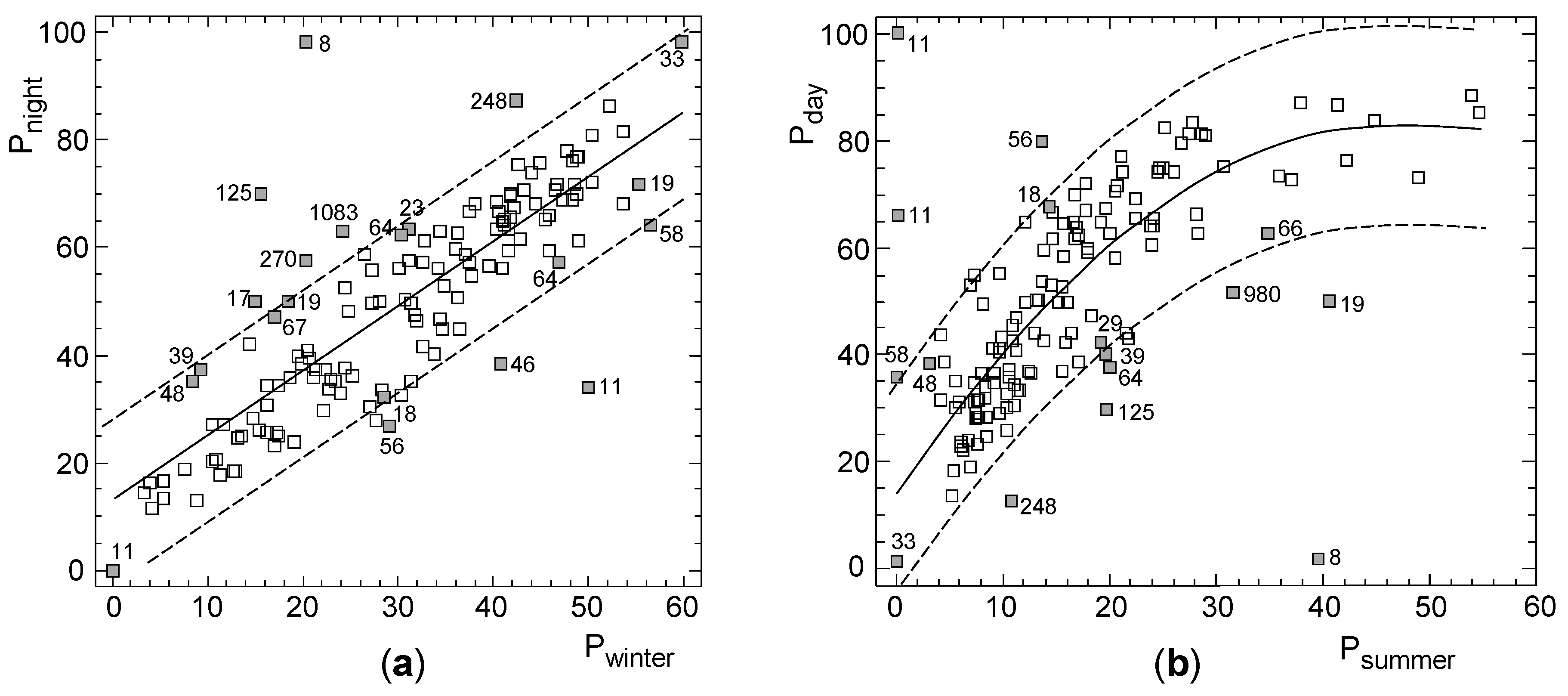
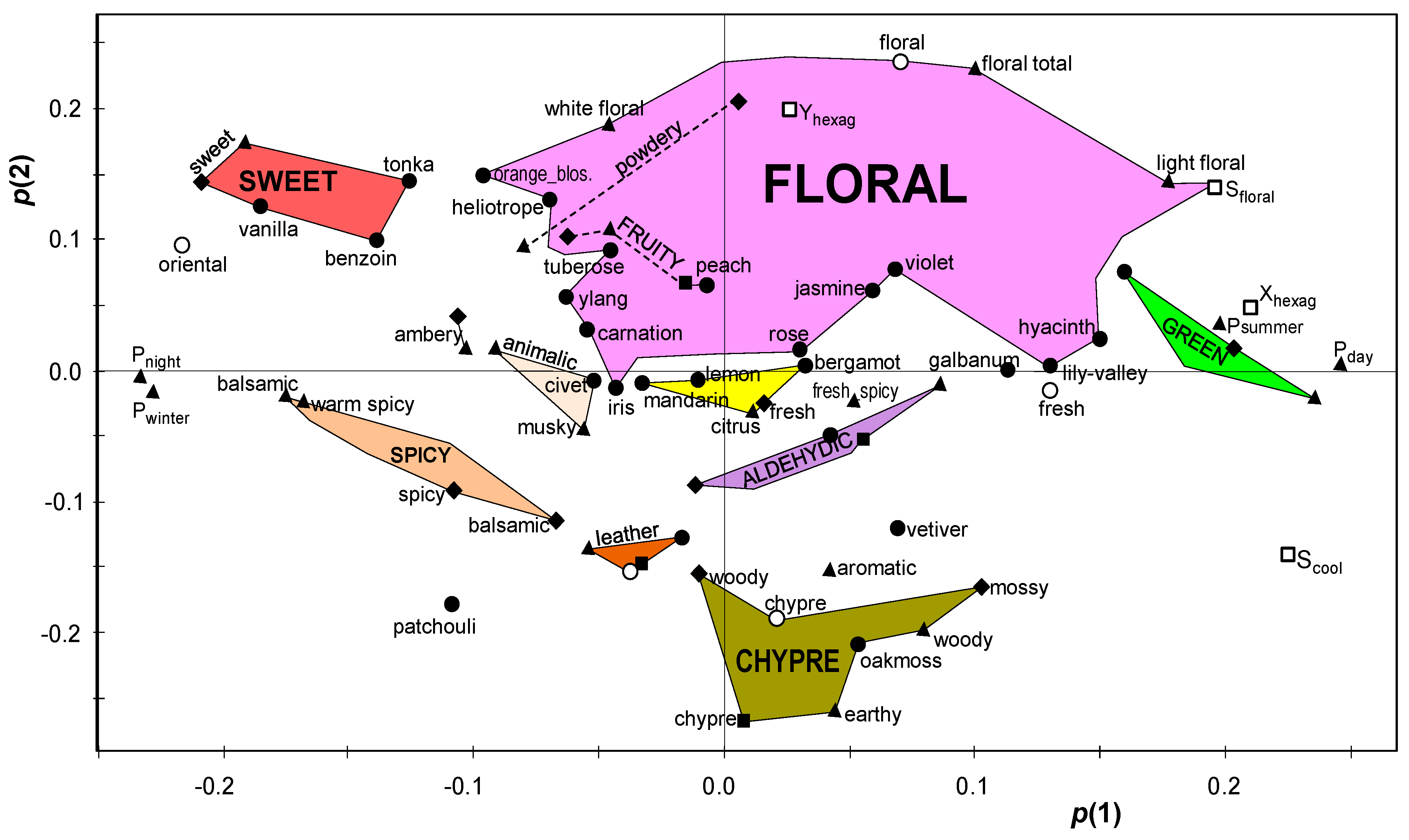
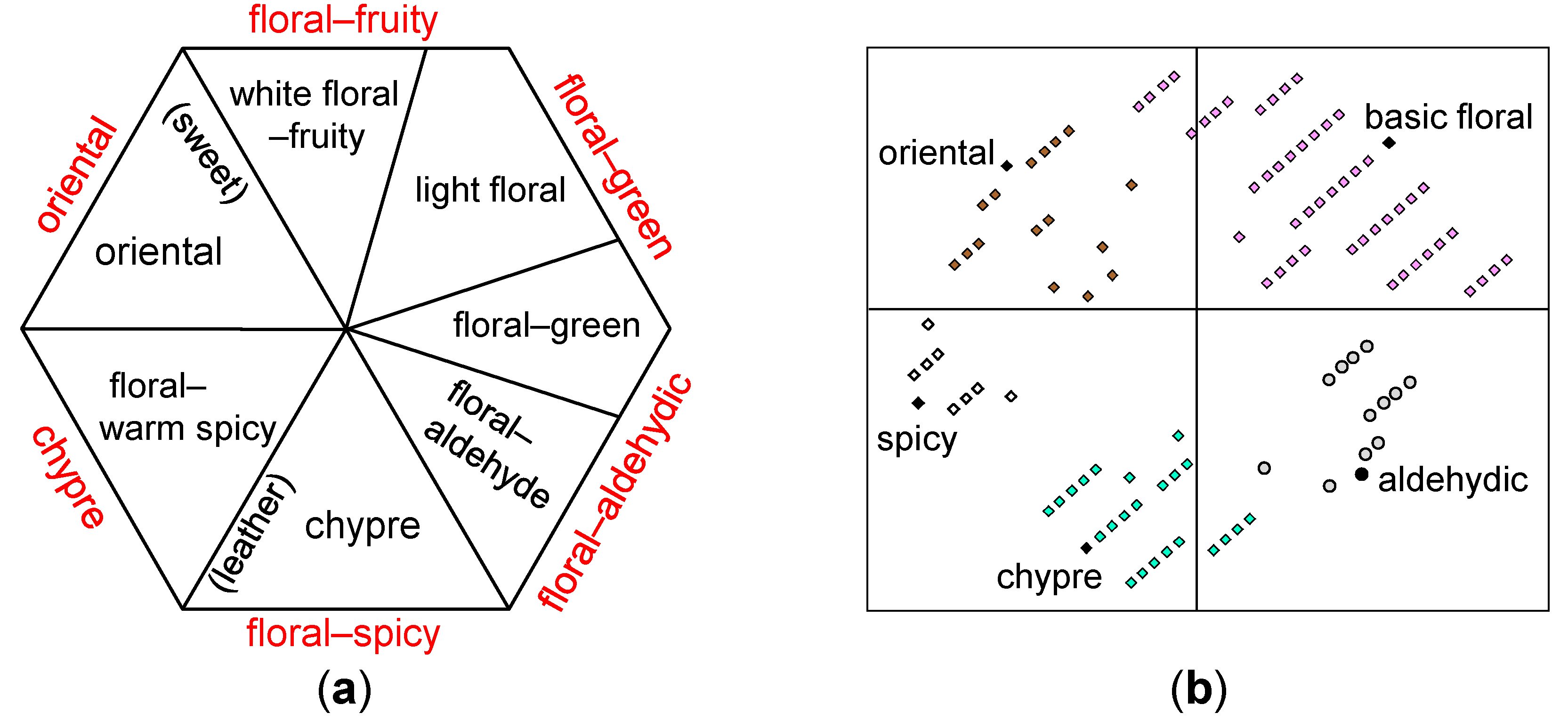
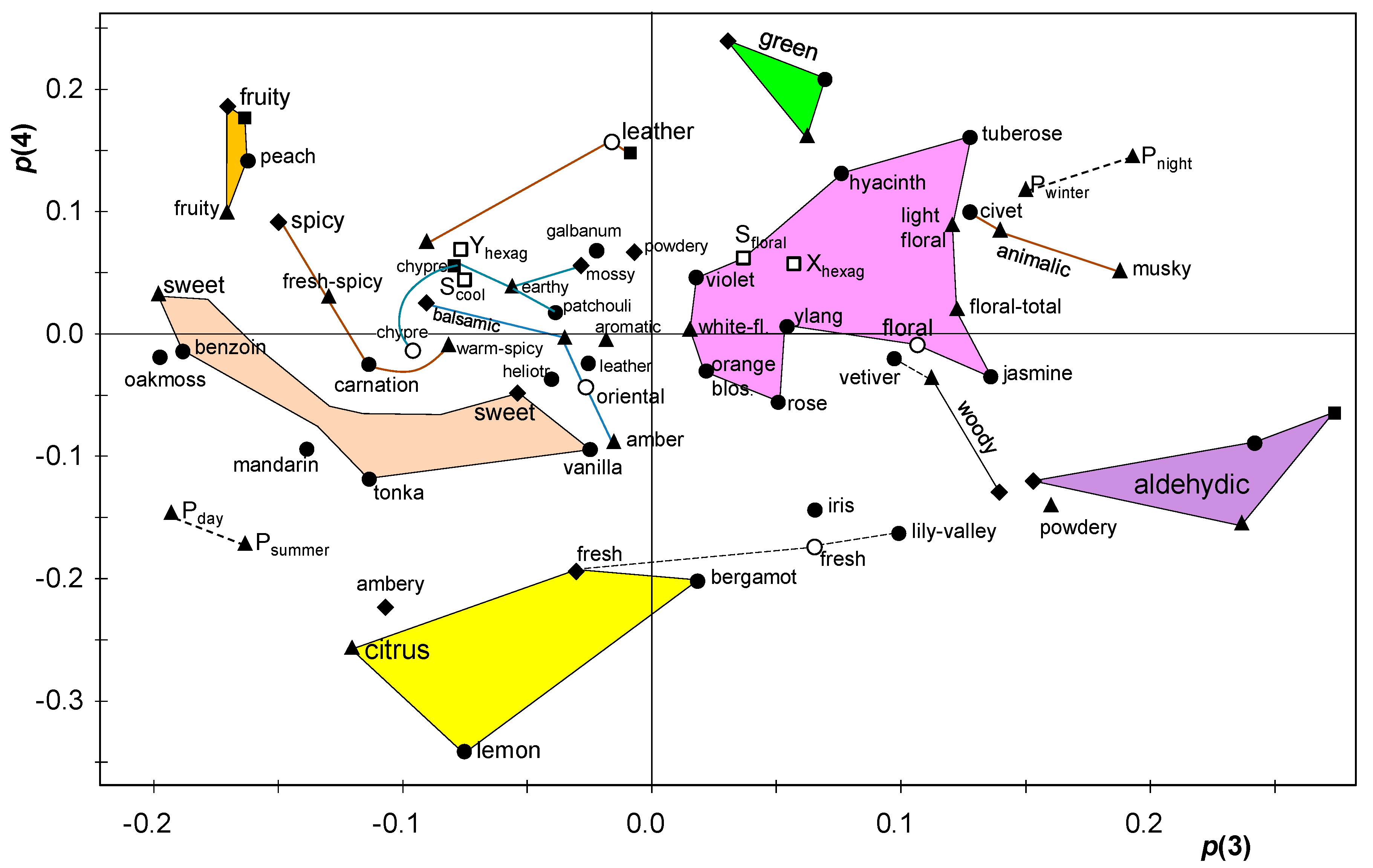
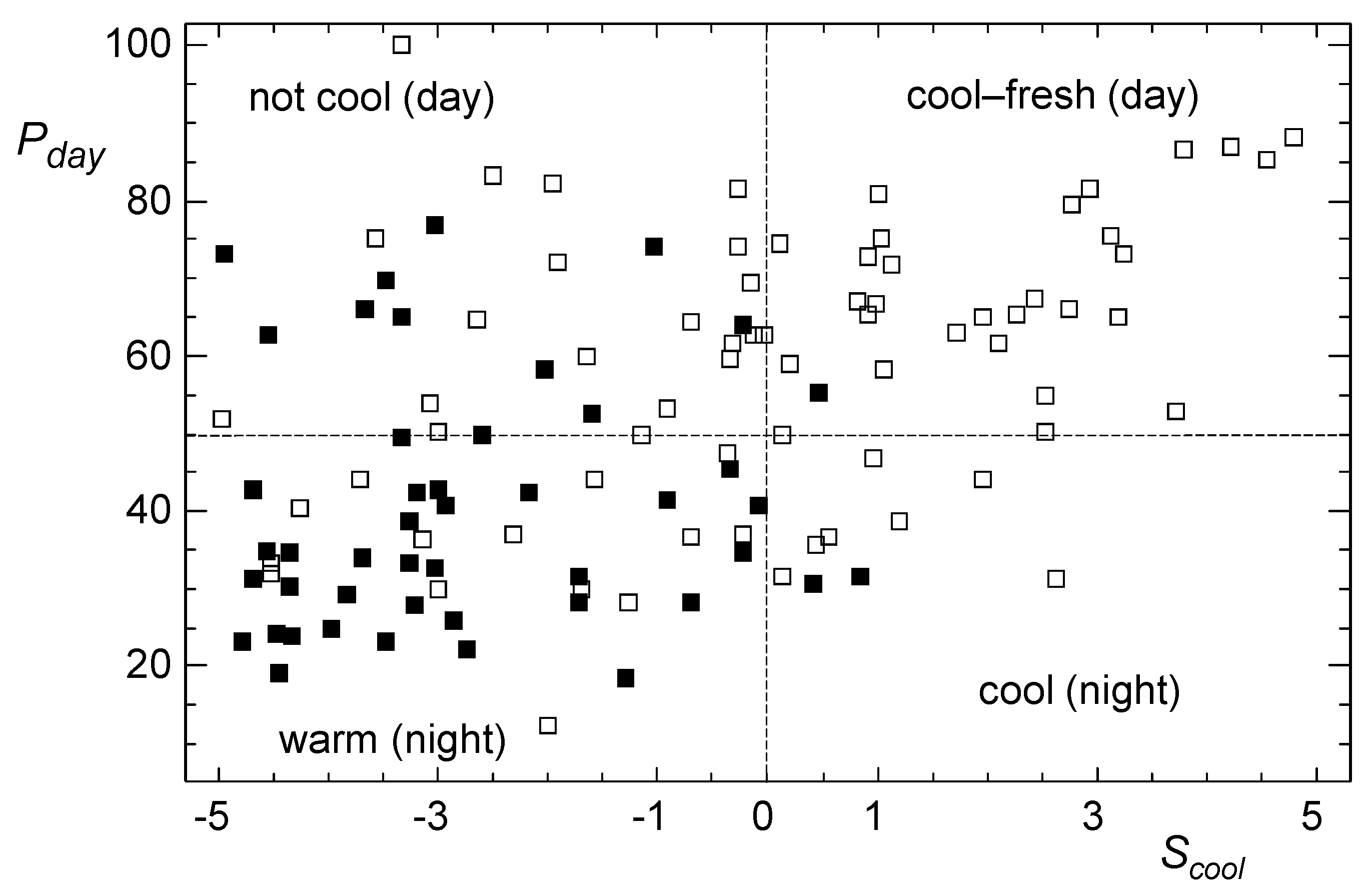

| Source | Nobs | Variables | ||||
|---|---|---|---|---|---|---|
| Values | Nexcl | Nincluded | Code 1 | |||
| Hexagon of Fragrances [23] | 89 | −5 to 5 | 0 | 2 | Xhexag, Yhexag | □ |
| Jellinek [14,25] | 118 2 | −5 to 5 | 0 | 2 | Scool, Sfloral | □ |
| FrD: from preferences | 137 | in % | 0 | 4 | Pday, Pnight, Psummer, Pwinter | ▲ |
| FrD: from main accords | 137 | 0 to 5 | 12 | 19 | Xaldehydic, Xamber, Xanimalic, Xaromatic, Xbalsamic, Xcitrus, Xearthy, Xfloral-total, Xfresh-spicy, Xfruity, Xgreen, Xleather, Xmusky, Xlight-floral, Xpowdery, Xsweet, Xwarm-spicy, Xwhite-floral, Xwoody | ▲ |
| H&R guide [5] | 136 | 0 or 1 | 16 | 11 | Ialdehydic, Iambery, Ibalsamic, Ifresh, Ifruity, Igreen, Imossy, Ipowdery, Ispicy, Isweet, Iwoody | ♦ |
| Osmoz website [7] | 93 | 0 or 1 | 70 | 26 | Oaldehyde, Obenzoin, Obergamot, Ocarnation, Ocivet, Ogalbanum, Ogreen, Oheliotrope, Ohyacinth, Oiris, Ojasmine, Oleather, Olemon, Olily-valley, Omandarin, Ooakmoss, Oorange-blossom, Opatchouli, Opeach, Orose, Otonka-bean, Otuberose, Ovanilla, Ovetiver, Oviolet-blossom, Oylang-ylang | ● |
| Edwards’s guide (EdG) [12] | 125 | 0 or 1 3 | - | 5 | Edchypre, Edleather, Edfloral, Edoriental, Edfresh | ○ |
| Several sources 4 | 140 | 0 or 1 | - | 4 | Zchypre, Zleather, Zaldehyde, Zfruity | ■ |
| From Fragrantica 1 (n = 140) | NFrag | PFrag | From H&R 2 (n = 453) | NH&R | PH&R | |
|---|---|---|---|---|---|---|
| Woody | 117 | 83.6 | Woody | 178 | 39.3 | |
| Floral (84) or related descriptors 3 | 113 | 80.7 | Floral (447) or rosy (17) | 448 | 98.9 | |
| Aromatic (46) or fresh spicy (24) | 59 | 42.1 | Fresh (239) or cool (23) | 250 | 55.2 | |
| Powdery | 56 | 40.0 | Powdery | 241 | 53.2 | |
| Green | 55 | 39.3 | Green | 155 | 34.2 | |
| Balsamic | 51 | 36.4 | Balsamic | 63 | 13.9 | |
| Sweet (36) or vanilla (7) | 40 | 28.6 | Sweet | 124 | 27.4 | |
| Warm spicy (38) or cinnamon (3) | 38 | 27.1 | Spicy | 86 | 19.0 | |
| Musky (17) or animalic (26) | 34 | 24.3 | Musky (3) or sensual (70) | 73 | 16.1 | |
| Earthy | 30 | 21.4 | Mossy | 72 | 15.9 | |
| Citrus | 22 | 15.7 | Citrus (16) or related 4 | 22 | 4.9 | |
| Aldehydic | 19 | 13.6 | Aldehydic | 133 | 29.4 | |
| Fruity | 10 | 7.1 | Fruity | 150 | 33.1 | |
| Amber | 9 | 6.4 | Ambery | 62 | 13.7 | |
| Leather | 7 | 5.0 | Leathery | 12 | 2.6 | |
| Smoky | 5 | 3.6 | Smoky | 0 | 0.0 | |
| Honey | 2 | 1.4 | Honey | 1 | 0.2 | |
| Herbal | 1 | 0.7 | Herbaceous | 10 | 2.2 | |
| Marine | 1 | 0.7 | Marine | 1 | 0.2 | |
| Tobacco | 1 | 0.7 | Tobacco | 0 | 0.0 | |
| Tropical | 1 | 0.7 | Tropical | 0 | 0.0 | |
| Dry | 0 | 0.0 | Dry | 20 | 4.4 |
| Base Note | Heart Note | Top Note | Top Note (Minority Terms) | |||||||||||
|---|---|---|---|---|---|---|---|---|---|---|---|---|---|---|
| Descriptor 1 | POSM | PH&R | Descriptor 1 | POSM | PH&R | Descriptor 1 | POSM | PH&R | Descriptor 1 | POSM | PH&R | |||
| Sandalwood | 62.4 | 70.4 | Rose | 66.7 | 87.9 | Bergamot | 58.1 | 81.7 | Melon | 3.2 | 2.9 | |||
| Vanilla | 36.6 | 41.9 | Jasmine | 59.1 | 95.1 | Aldehyde | 26.9 | 52.8 | Grapefruit | 3.2 | 0.7 | |||
| Patchouli | 34.4 | 34.2 | Tuberose | 37.6 | 34.4 | Peach | 26.9 | 32.9 | Raspberry | 2.2 | 8.6 | |||
| Oakmoss | 32.3 | 57.0 2 | Iris (orris) 5 | 34.4 | 70.6 | Lemon | 24.7 | 32.7 | Pimento 6 | 2.2 | 4.0 | |||
| Vetiver | 32.3 | 43.7 | Lily-of-the-valley | 33.3 | 57.8 | Hyacinth | 22.6 | 24.7 | Reseda | 2.2 | 1.3 | |||
| Cedar | 30.1 | 51.7 3 | Ylang ylang | 23.7 | 62.3 | Orange blossom | 22.6 | 19.4 | Pepper | 2.2 | 0.9 | |||
| Musks | 25.8 | 83.4 | Carnation | 21.5 | 52.5 | Mandarin | 20.4 | 15.0 | Coconut | 2.2 | 0.9 | |||
| Amber | 24.7 | 71.3 | Narcissus | 12.9 | 13.2 | Galbanum | 18.3 | 16.3 | Angelica | 2.2 | 0.7 | |||
| Benzoin | 20.4 | 38.9 | Violet | 10.8 | 10.2 | Coriander | 16.1 | 18.3 | Cassie | 1.1 | 8.8 | |||
| Civet | 17.2 | 39.3 | Geranium | 9.7 | 7.5 | Green notes | 15.1 | 44.6 | Chalice flower | 1.1 | 2.9 | |||
| Tonka bean | 11.8 | 20.3 | Cloves | 9.7 | 5.3 | Rosewood | 9.7 | 20.1 | Mace | 1.1 | 2.4 | |||
| Heliotrope | 11.8 | 14.3 | Cinnamon | 8.6 | 9.9 | Neroli | 9.7 | 10.4 | Artemisia | 1.1 | 2.4 | |||
| Leather | 6.5 | 13.9 | Gardenia | 7.5 | 11.9 | Blackcurrant | 8.6 | 0.2 | Cumin | 1.1 | 1.8 | |||
| Labdanum ciste | 6.5 | 10.8 4 | Cyclamen | 7.5 | 11.9 | Plum | 7.5 | 6.8 | Lavender | 1.1 | 1.5 | |||
| Styrax | 5.4 | 9.7 | Honeysuckle | 6.5 | 2.6 | Citrus oil | 6.5 | 6.0 | Petitgrain | 1.1 | 1.1 | |||
| Castoreum | 4.3 | 7.1 | Honey | 4.3 | 11.7 | Pineapple | 6.5 | 5.5 | Laurel leaves | 1.1 | 1.1 | |||
| Olibanum | 2.2 | 5.5 | Lily | 4.3 | 5.3 | Orange | 5.4 | 6.6 | Pine needle | 1.1 | 0.4 | |||
| Oppoponax | 2.2 | 4.6 | Mimosa | 3.2 | 1.3 | Basil | 5.4 | 6.6 | Marigold | 1.1 | 0.2 | |||
| Peru balsam | 2.2 | 1.8 | Orchid | 1.1 | 17.0 | Anise | 5.4 | 2.2 | Chamomile | 1.1 | 0.2 | |||
| Myrrh | 1.1 | 4.0 | Lilac | 1.1 | 7.5 | Clary sage | 4.3 | 4.0 | Rosemary | 1.1 | 0.2 | |||
| Marine note | 1.1 | 0.4 | Thyme | 1.1 | 1.8 | Cardamom seed | 4.3 | 3.1 | Tagetes | 0.0 | 7.1 | |||
| Tolu | 0.0 | 4.0 | Linden | 1.1 | 0.9 | Tarragon | 3.2 | 4.2 | Strawberry | 0.0 | 1.1 | |||
| Magnolia | 1.1 | 0.9 | Spearmint | 3.2 | 3.5 | Marjoram | 0.0 | 0.4 | ||||||
| Ginger | 1.1 | 0.4 | Apricot | 3.2 | 2.9 | |||||||||
| Occurrences | Percentages | Occurrence | Percentage | |||||||||
|---|---|---|---|---|---|---|---|---|---|---|---|---|
| Class | NED | N125 | PED | P125 | Class | NED | N125 | PED | P125 | |||
| Floral | 1446 | 27 | 41.8 | 21.6 | Citrus | 146 | 2 | 4.2 | 1.6 | |||
| Floral oriental | 533 | 19 | 15.4 | 15.2 | Dry woods | 47 | 7 | 1.4 | 5.6 | |||
| Soft floral | 354 | 14 | 10.2 | 11.2 | Woods | 71 | 0 | 2.1 | 0 | |||
| Woody oriental | 352 | 12 | 10.2 | 9.6 | Green | 33 | 5 | 1.0 | 4.0 | |||
| Mossy woods | 175 | 24 | 5.1 | 19.2 | Watery | 35 | 1 | 1.0 | 0.8 | |||
| Oriental | 145 | 5 | 4.2 | 4.0 | Fruity | 21 | 0 | 0.6 | 0 | |||
| Soft oriental | 97 | 9 | 2.8 | 7.2 | Fougère | 8 | 0 | 0.2 | 0 | |||
© 2020 by the author. Licensee MDPI, Basel, Switzerland. This article is an open access article distributed under the terms and conditions of the Creative Commons Attribution (CC BY) license (http://creativecommons.org/licenses/by/4.0/).
Share and Cite
Zarzo, M. Multivariate Analysis of Olfactory Profiles for 140 Perfumes as a Basis to Derive a Sensory Wheel for the Classification of Feminine Fragrances. Cosmetics 2020, 7, 11. https://doi.org/10.3390/cosmetics7010011
Zarzo M. Multivariate Analysis of Olfactory Profiles for 140 Perfumes as a Basis to Derive a Sensory Wheel for the Classification of Feminine Fragrances. Cosmetics. 2020; 7(1):11. https://doi.org/10.3390/cosmetics7010011
Chicago/Turabian StyleZarzo, Manuel. 2020. "Multivariate Analysis of Olfactory Profiles for 140 Perfumes as a Basis to Derive a Sensory Wheel for the Classification of Feminine Fragrances" Cosmetics 7, no. 1: 11. https://doi.org/10.3390/cosmetics7010011
APA StyleZarzo, M. (2020). Multivariate Analysis of Olfactory Profiles for 140 Perfumes as a Basis to Derive a Sensory Wheel for the Classification of Feminine Fragrances. Cosmetics, 7(1), 11. https://doi.org/10.3390/cosmetics7010011





